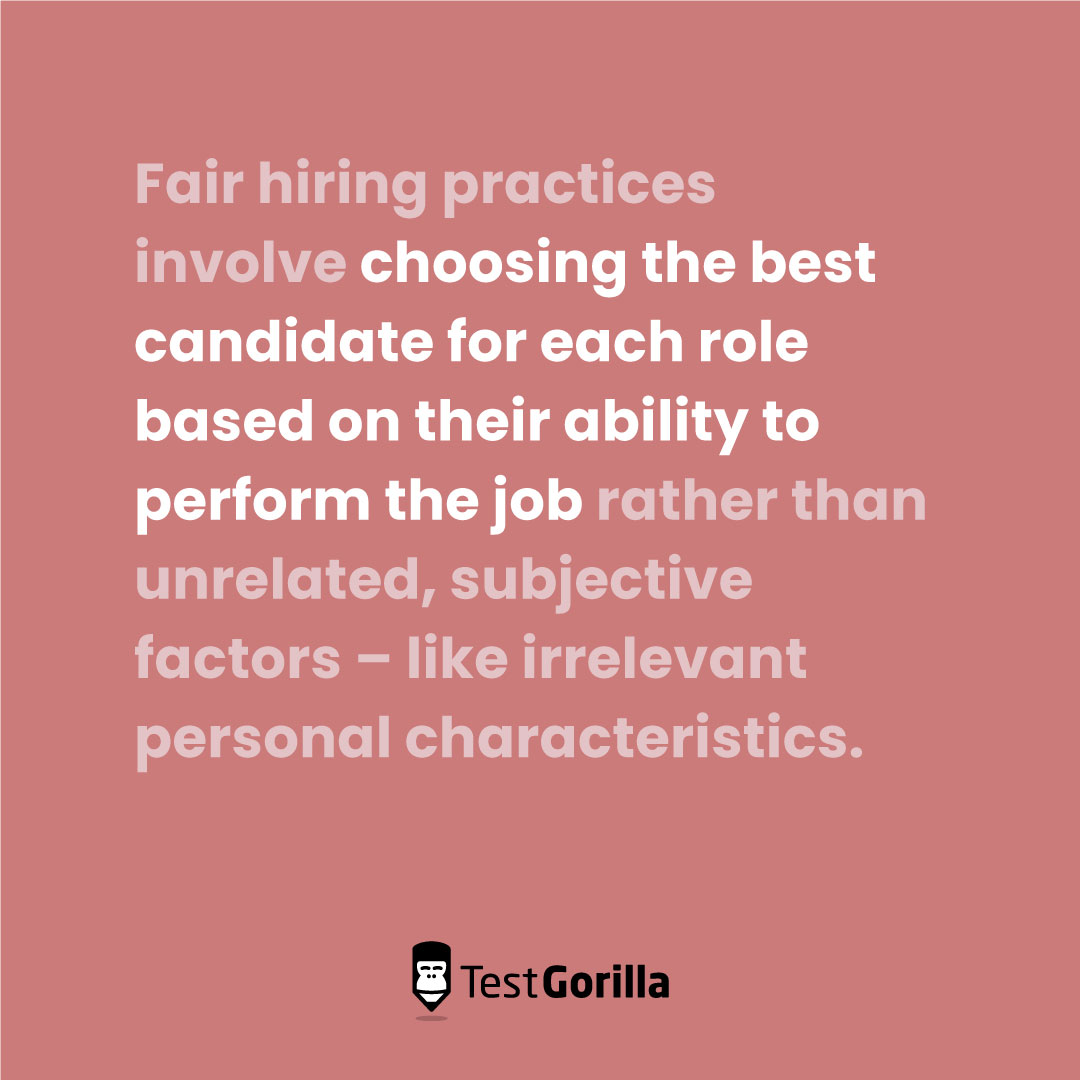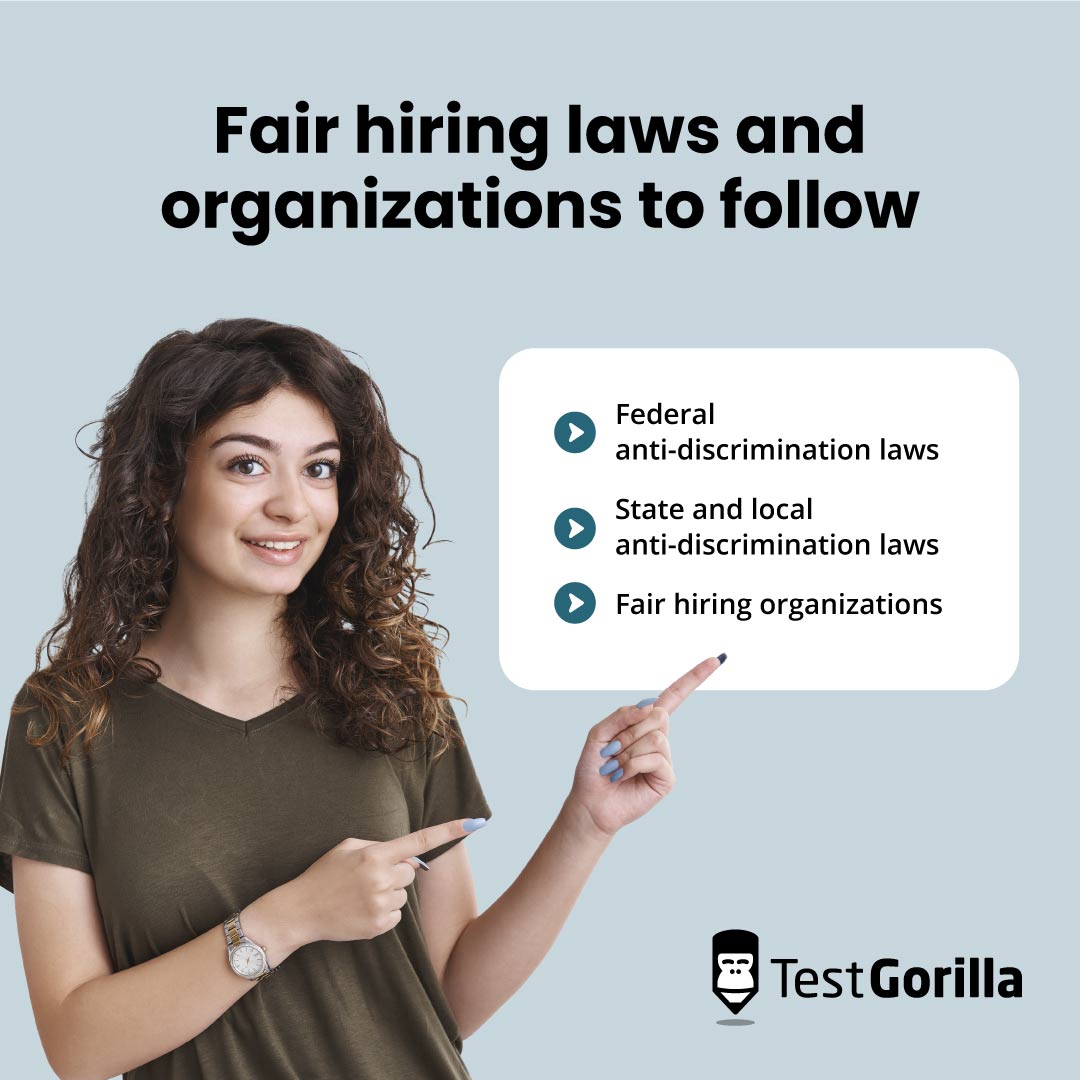Employers’ guide to fair hiring practices and why they’re important
Most hiring managers focus intently on finding the best person for the job, but spending time and energy ensuring hiring practices are fair is equally important.
Fair hiring practices seek to level the playing field for all candidates and promote diversity in your workforce. Understanding these practices and how they differ from unfair practices is crucial to removing unconscious bias from recruitment and reducing the potential legal risks associated with noncompliance, including fines and lawsuits.
But familiarizing yourself with these practices and applying them to your business isn’t always easy.
That’s why this article provides an easy-to-understand overview of fair hiring practices and their related laws. Plus, we include 12 tips for integrating fair practices into your recruitment process.
What are fair hiring practices?
The best hiring practices for employers involve choosing the best candidate for each role based on their ability to perform the job rather than unrelated, subjective factors – like irrelevant personal characteristics. These practices ensure merit-based selection and prevent discrimination from occurring during the hiring process.
Employers should apply fair hiring practices to every stage of the recruitment process, from job advertisements to onboarding.
Fair hiring practices involve complying with anti-discrimination laws and implementing policies and strategies to eliminate unfair hiring practices. Examples of unfair practices include hiring someone on their resume alone, discriminating against candidates during recruitment, and using unstructured interview questions unrelated to job skills and knowledge.
Why is fair hiring important?
Fair hiring ensures equal employment opportunity (EEO) for all. This means nobody is disadvantaged when applying for a job due to factors outside their control, such as race or gender.
From an employer’s perspective, fair hiring practices support diversity, equity, and inclusion (DEI) in your organization. A range of benefits make a compelling business case for DEI, including greater innovation, more efficient problem-solving, increased productivity, and reduced turnover.
Various federal, state, and local anti-discrimination laws support fair hiring. Failing to comply means you risk facing fines, formal complaints resulting in investigations, or lawsuits. Adopting fair hiring in your organization minimizes this risk.
The best insights on HR and recruitment, delivered to your inbox.
Biweekly updates. No spam. Unsubscribe any time.
Fair hiring laws and organizations to follow
Federal anti-discrimination laws
Some key federal anti-discrimination laws support fair hiring. These laws apply to all stages of the employment lifecycle, but in this article, we focus on how they apply to hiring in particular, including job advertisements, job applications, interviews, and background checks.
Unless stated otherwise, these laws apply to employers with 15 or more employees.
Title VII of the Civil Rights Act: Prohibits discrimination based on race, color, national origin, religion, and sex, including pregnancy, gender identity, and sexual orientation. Refusing to hire someone because of their religious attire, like a hijab or turban, would violate this act.
Equal Pay Act (EPA): Requires all employers to provide equal pay for employees who perform the same job with the same level of experience, regardless of gender. For example, you can’t offer candidates a different salary because they’re women.
Age Discrimination in Employment Act (ADEA): Prevents employers with 20 or more employees from discriminating against someone over 40. Including phrases like “youthful and energetic” in a job advertisement as criteria for a position can be considered age discriminatory.
Title I of the Americans with Disabilities Act (ADA): Prohibits employers from discriminating against someone based on disability. Employers must make reasonable accommodations (adjustments) for applicants and employees with disabilities unless doing so would cause them “undue hardship,” meaning they would incur significant difficulty or expense. Reasonable accommodations may include providing sign language interpreters for applicants with hearing impairments during interviews.
Title II of the Genetic Information Nondiscrimination Act (GINA): States that employers can’t discriminate against someone based on their genetic information, including family medical history. Declining a candidate after a background check reveals a family history of a hereditary disease would violate this act.
The Pregnant Workers Fairness Act (PWFA): Requires employers to make reasonable accommodations for employees experiencing issues arising from pregnancy, childbirth, or other related medical conditions. Examples include providing seating for pregnant applicants during interviews. However, an employer doesn’t have to make an accommodation if doing so would cause them undue hardship.
Uniformed Services Employment and Reemployment Rights Act (USERRA): Prohibits all employers from discriminating against military service members and veterans based on past, present, or future service. It also ensures these individuals can return to their jobs after serving. Overlooking candidates for a position because their resume indicates a recent long-term military deployment would violate this act.
State and local anti-discrimination laws
States and localities often have anti-discrimination laws that promote fair hiring. When multiple rules apply to your business, the one that offers the most protection to the employee typically prevails.
Fair hiring organizations
The Equal Employment Opportunity Commission (EEOC) is a federal agency that enforces the above laws, except for USERRA. The EEOC can investigate complaints against employers accused of breaching these laws. The Office of Special Counsel, a federal investigative and prosecutorial agency, enforces the USERRA.
State and local agencies and organizations known as Fair Employment Practices Agencies enforce state and local anti-discrimination laws. Examples include the California Civil Rights Department, the Washington State Human Rights Commission, and the Colorado Civil Rights Division.
12 fair hiring practices to adopt for your next campaign
Integrate the following tips and best practices for a more objective recruitment process:
1. Understand the laws that apply to you
Before reviewing your hiring processes for fairness, you must understand your legal obligations around recruitment and selection. Confirm which federal, state, and local anti-discrimination laws apply to your business. You can then ensure that your hiring practices are compliant.
2. Use inclusive language in job ads
Write your job ads using neutral language without expressing a preference for a particular characteristic or discouraging candidates with specific characteristics from applying. For example, a job ad for “recent college graduates” may prevent people over 40 from submitting applications.
Ensure you use gender-neutral language. Substitute terms like “waitress” for “waitstaff,” for example. Using gender-neutral pronouns is also preferable, such as “they” instead of “he” or “she.”
3. Ensure your hiring methods are inclusive
Review your recruitment methods to ensure they’re inclusive. For example, do you only advertise at colleges that have graduates with specific profiles?
Ensure that your careers page on your company website is accessible to everyone. For example, add alt text and video captions and use appropriate color contrast for people with vision impairments. Also, consider whether the images on your careers page are inclusive. Do they show that you welcome candidates from diverse backgrounds to apply?
4. Promote your EEO policy
You should have a policy outlining the steps your organization takes to promote EEO. Make sure you address recruitment by explaining your EEO-compliant hiring processes, which tools you use, and your approach to fair hiring.
Include a link to your EEO policy in your job advertisements and careers page. Doing so demonstrates your commitment to transparency, fair hiring practices, and your willingness to accept accountability for your set standards.
5. Adopt anonymous recruiting practices
Anonymous or blind recruitment involves removing subjective, non-job-related information from the initial stages of the hiring process. You can use software that anonymizes candidates’ resumes by removing their names and dates of birth from job applications or pre-screening those resumes for objective information only.
This helps eliminate unconscious bias from the hiring process, ensuring the hiring panel focuses purely on objective criteria.
6. Use only job-related selection criteria
The selection criteria in your job advertisement should relate directly to the role’s tasks and responsibilities. Identify the knowledge, skills, and abilities required for the position. When discussing required attitudes or behaviors in a job ad, ensure they link to your organization’s core values. Doing this minimizes the risk of introducing subjective, potentially discriminatory selection criteria.
7. Incorporate skills assessments
Adopting a skills-based approach to hiring by using pre-employment assessments promotes fair hiring. It helps you focus on objective, measurable skills rather than irrelevant personal characteristics. This leads to more equitable hiring practices and greater workplace diversity.
Include assessments for cognitive abilities, situational judgment, language skills, and other job-related skills, and ensure you give the same tests to all applicants applying for the same role.
When choosing a pre-employment testing provider, ensure it complies with relevant laws and regulations. For example, TestGorilla offers accommodations to candidates who require them to complete testing.
8. Ensure diversity in your hiring team
A diverse hiring panel contributes to diversity and fairness in your hiring processes. Having individuals with various backgrounds and experiences participate helps mitigate unconscious biases.
Plus, candidates see that your organization values inclusivity and diversity, reinforcing your fair hiring practices.
9. Train your hiring managers
Training is essential to help your hiring managers understand and apply fair hiring practices. Topics include unconscious bias, employment law, anti-discrimination law, and examples of unfair hiring practices and ways to avoid them.
While it’s unlikely your hiring team intentionally discriminates against candidates, training helps them understand the nuances of fair hiring practices and identify any unconscious biases.
10. Create standardized interview questions and structure
Creating a scripted list of interview questions helps remove unconscious bias from the hiring process. You should ask each candidate the same objective, job-related questions, preventing any subjective questions from creeping in.
You should also ensure the structure of your interviews is equal. For example, each candidate should receive equal interview time and the same information before their interview.
11. Conduct fair and legal background checks
Background checks can be valuable tools for verifying candidate information, such as their education, employment history, and criminal record. However, your background checks must comply with relevant federal, state, or local laws and regulations.
It’s best to conduct a background check after you’ve made a conditional offer of employment. In some states, Ban the Box laws make this a legal requirement. Regardless, this approach ensures you avoid making hiring decisions based solely on the results of a background check.
12. Retain your hiring records
Federal law requires you to keep hiring records for one year after their creation or the date of a related discrimination complaint – whichever is later.
Keeping these records enables you to respond to formal complaints against your organization and encourages accountability and transparency within your hiring team.
Using TestGorilla to support fair hiring practices
Fair hiring practices remove unconscious bias from recruitment processes, ensuring no candidate is unfairly disadvantaged. They help promote DEI in your organization while safeguarding you from potential fines or legal action for engaging in discriminatory hiring practices.
There are various fair hiring practices you can consider adopting. One is a skills-based approach to hiring using a pre-employment assessment platform like TestGorilla.
Try our free plan today to discover how TestGorilla can help you make unbiased hiring decisions – and find the best people for your jobs.
Disclaimer
The information in this article is a general summary for informational purposes and is not intended to be legal advice. Laws are subject to constant change, and their applications vary based on your individual circumstances. You should always seek legal advice from a qualified attorney about your legal obligations as an employer. While this summary is intended to be informative, we cannot guarantee its accuracy or applicability to your situation.
You've scrolled this far
Why not try TestGorilla for free, and see what happens when you put skills first.




















